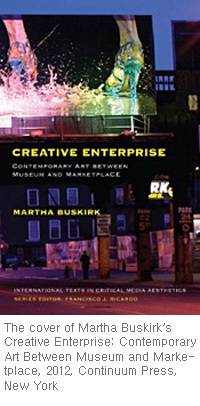재미있는 신간 하나
by Emily Nathan
Contemporary Art Books

Martha Buskirk, Creative Enterprise: Contemporary Art between Museum and Marketplace, 2012, Continuum Press, New York, 392 pp., $39.95.
In her new book Creative Enterprise: Contemporary Art between Museum and Marketplace, released last month by Continuum Press, the scholar Martha Buskirk cuts the crap, to use an appropriately unsavory term, and makes it almost impossible for the rest of us not to. Art and money, money and art -- these seemingly contrary functions are inextricably linked, she asserts, and have always been. Hardly a novel idea, though we still seem loathe to admit it.
Buskirk makes her case with clarity and a healthy dose of cynicism, and the results are both refreshing and tremendously depressing. “In a version of circular logic,” she writes, “art is set off from other forms of production based on cultural significance assumed to extend well beyond monetary value. Yet the more that art comes to resemble familiar goods and services, the more the price alone sets it apart.”
Art’s frequent superficiality and money-mindedness should come as no surprise, considering what Buskirk describes as art’s “lengthy history of contradiction,” and it is this notion that shapes her argument throughout the book. She begins with institutional display, pioneered in the 16th century by the public museum, which was developed as a method for dealing with the elaborate possessions of aristocrats after their death. The initial tactic employed by the institution was to lump everything together into “encyclopedic collections” defined by the “cabinet of curiosities” esthetic, which has recently resurfaced in contemporary art. But with the passing of centuries, specific departments emerged and soon fine art was given its very own showroom.
Strategies of accession and deaccession are instrumental here, but Buskirk moves quickly along to get to her point -- which is simply that the emphasis of the museum has always been on spectacle, on presenting objects that are displaced from functionality and context for the sole purpose of patrons’ consumption. And while museums, “palaces of pilgrimage to the commodity fetish” in the words of Walter Benjamin, were created as repositories for the spoils of the wealthy, they have always been promoted as altruistic tools meant to educate all classes (or at least those who could afford to get in).
This hypocrisy is familiar, though nobody would argue against the value of such institutions. This duality forms the backbone of the troubling paradox that Buskirk feels defines our contemporary situation: many of the more innovative and important developments in art of the last half-century have also cleared the way for art’s manipulation, corruption and debasement.
Take institutional critique, a conceptual art genre that supposedly challenges the elitism, politics and subjectivity inherent to exhibition and collection formation. Institutional critique has certainly had its effects on both artistic and museum conventions, often liberating ones, and Buskirk illustrates this argument with the familiar practices of
Fred Wilson,
Andrea Fraser and
Sophie Calle, the usual suspects. But these artists, and many others like them, have been successfully absorbed into the very system they purport to reject, and their work has opened up a space for artistic practices which are dependent on the institutions they ostensibly take issue with.
It would seem that nobody has a problem selling out these days. It’s a dog eat dog world, and gestures that might have been renegade in the past have lost their power as the notion of critique has been sublimated into a “potentially marketable badge of honor.”
Buskirk doesn’t spare “relational esthetics” either. Although the displacement of attention away from the “art object” is one of the most significant developments in modern art, the more recent embrace of almost any activity in the name of the “artistic” is highly problematic. As
Allan Kaprow wrote in his 1966
Manifesto, “Once, the task of an artist was to make good art. Now it is to avoid making art of any kind.”
Rirkrit Tiravanija turns a gallery into a soup kitchen that serves well-heeled dealers and art critics;
Tino Sehgal empties the Guggenheim and offers those visitors who can afford to pay museum entrance the chance to talk with hired actors.
Under the auspice of “promoting dialogue,” Buskirk points out, what frequently results from art of the relational persuasion is just an excuse for a party, a model centered on opening-night festivities and social events which loses its power after the initial celebration is over, serving only the community to which it already caters. Plus, these “experiential situations” are often cop-outs. “Take daily life,” Buskirk quips, “turn it into a self-conscious pastiche of itself, make a video record, and rake in the profits.” Ouch.
Finally Buskirk turns her attention to the idea of authorship, first engaged subversively by
Marcel Duchamp and his readymades. But now, as seen with many artists like
Jeff Koons,
Takashi Murakami and
Damien Hirst, the idea of “artist as brand operates without irony in the context of market hype.” This marks art’s absolute entrenchment into the system of commerce, with methods for production, dissemination, marketing and promotion that exactly emulate corporate strategies for commercial products. What is the difference, these days, between the creative work of an ad man and an artist? How can and why should art stand apart from other creative, commercial endeavors, when its production and reception have become indistinguishable from theirs?
For those of us in the art world who have trouble sleeping at night, this book won’t help. Buskirk slices through the abstract and romantic rhetoric we often use to mollify our guilt and replaces it with humbling, realistic facts. She frames art undeniably as a “bauble of the rich, enmeshed in a larger luxury trade and functioning as a marker of status,” even while she admits to hoping that it fulfills other roles as well. Despite art’s evident virtues, Buskirk goes straight to the heart of the most frustrating, baffling and universally accepted hypocrisies of the art world. And that makes for a surprising, disillusioning, enlightening ride.
